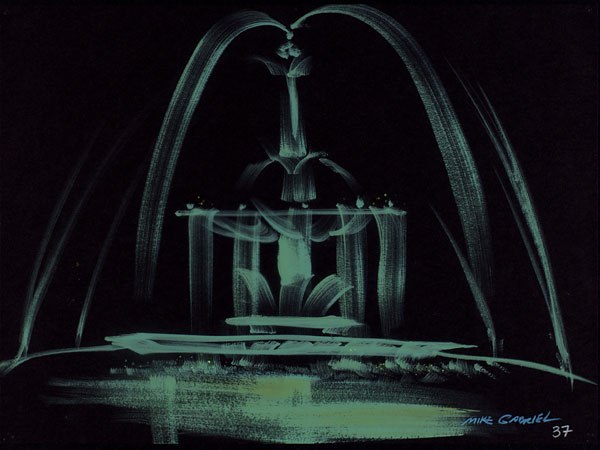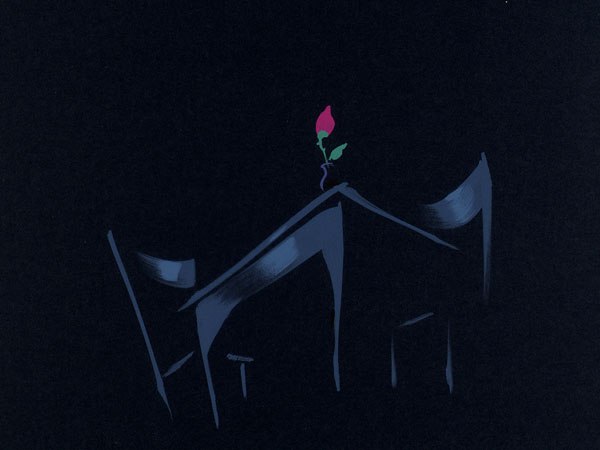In part one of the Lorenzo visual development gallery, VFXWorld provides an exclusive look at some of Mike Gabriels stunning background paintings for this groundbreaking short.
Walt Disney Pictures acclaimed new short, Lorenzo, currently playing in theaters with Raising Helen and screening June 7 at Annecy 2004, uniquely captures Mike Gabriels artistic vision by bringing his raw brushstroke style directly to the screen with the aid of a digital painterly renderer called Sable. The look and emotion of the art is seen in Lorenzos moving painting approach, which is part traditional and part CG in telling its funny tale about a nasty blue cat with a tail that magically comes to life. The result, set to a tantalizing tango, is a liberating tour-de-force for Gabriel, who directed, designed, storyboarded and painted all of the backgrounds.
In part one of VFXWorlds exclusive visual development gallery, we focus on Lorenzos backgrounds. All of Gabriels pieces were done with tempera paints on black construction paper, which contained just the right texture and surface for his blue cat and vivid South American setting.
I realized real quick this has got to be in the nighttime; its got to be a tango setting with a spotlight, so everything just led to the black world, and, I guess, Ive always had an affection for the 40s Disney stuff with Mary Blair and Saludos Amigos and Three Caballeros kind of stuff, Gabriel explained.
What I was really able to do because it was such a personal, singular kind of vision, was to get a feel for the backgrounds. I would just break it down with a brush in my hand and would not be intimidated in any way. I would just feel the emotion I wanted to convey in a scene. Just feel it right inside of myself, feel whatever that paintbrush was going to do when it hit the paper, and see what it looks like. It was such a facile thing to throw some paint on cheap black construction paper, throw it on the ground and go on to the next one. So it really became fun the deeper we got into the story.
When I started doing the breakdown scenes where Lorenzo loses it and goes haywire, its an old style to just flash backgrounds behind the character, but the speed and intensity of those paintings is neat if you really slow it down frame by frame. When hes staring at the camera and just loses it, he starts to vibrate; those backgrounds are just so insanely painted because I just really went to that place inside and just felt it and then just started firing it down on paper. I thought, OK, whats a new way to express that? So I just started firing all this pure insanity, just the red paint on the black paper and I could never keep the red as hot as I wanted, but digitally we could pump it a little more. And I just had so much fun just throwing paint down and thinking, If was scared out of my mind, what would the world look like to me?
One thing I did that will help explain the look, as I was painting the fountain, I thought, Just let me do this stroke, this stroke, this stroke, a couple of these and fling the water and you would look at that and know [its] a fountain. Now why should I paint anything else in this image when you already know that its a fountain and thats all that Im trying to convey? And I painted every background [the same way]. I just started going the next one less, less, less until Im down to saying a table and chairs in like three strokes. And it becomes a little more ominous when you leave out half of an image, but knowing just how many strokes I could get away with proved to be the point of success with the backgrounds.
Bill Desowitz is editor of VFXWorld.

After first painting the blue cat on white paper, using a wide brush for a simple design shape, Gabriel listened more closely to the ominous music and started to visualize the story with more black. All images © Disney.

One of Gabriels visual tricks was to use gray-green to neutralize the colors surrounding the blue cat, while at the same time paying homage to the South American cafes with a checkerboard floor.

Using La Boca photographs as inspiration, Gabriel captured the wild, brightly colored nightlife, highlighted by red streetlights.

The warped and twisted window into Lorenzos world reminded Gabriel of a black Disneyland storybook ride.

For the fountain, Gabriel chose a simple hueless look to evoke the cosmopolitan beauty of Buenos Aires.

The cool jazz aura that Gabriel sought was often just a subtle trick laying low before the brightly colored fireworks at the end.










